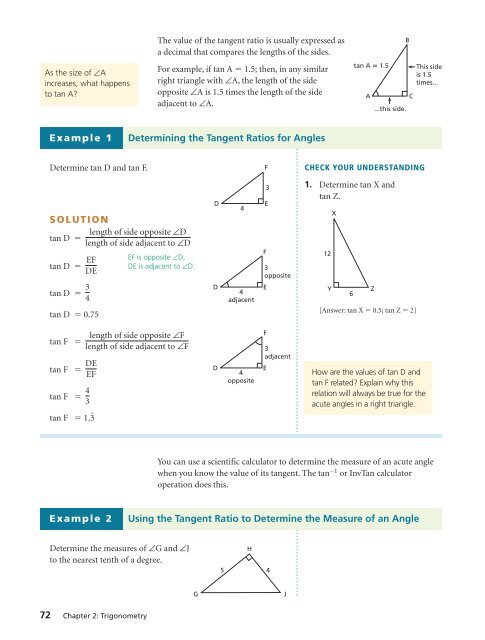SCIENCE WORLD This building was constructed for the Expo '86 ...
SCIENCE WORLD This building was constructed for the Expo '86 ...
SCIENCE WORLD This building was constructed for the Expo '86 ...
Create successful ePaper yourself
Turn your PDF publications into a flip-book with our unique Google optimized e-Paper software.
As <strong>the</strong> size of ∠A<br />
increases, what happens<br />
to tan A?<br />
Determine tan D and tan F.<br />
SOLUTION<br />
length of side opposite ∠D<br />
tan D �<br />
length of side adjacent to ∠D<br />
72 Chapter 2: Trigonometry<br />
The value of <strong>the</strong> tangent ratio is usually expressed as<br />
a decimal that compares <strong>the</strong> lengths of <strong>the</strong> sides.<br />
For example, if tan A � 1.5; <strong>the</strong>n, in any similar<br />
right triangle with ∠A, <strong>the</strong> length of <strong>the</strong> side<br />
opposite ∠A is 1.5 times <strong>the</strong> length of <strong>the</strong> side<br />
adjacent to ∠A.<br />
Example 1 Determining <strong>the</strong> Tangent Ratios <strong>for</strong> Angles<br />
tan D �<br />
tan D �<br />
tan D � 0.75<br />
tan F �<br />
tan F �<br />
tan F �<br />
EF<br />
DE<br />
3<br />
4<br />
DE<br />
EF<br />
4<br />
3<br />
tan F � 1.3 ¯<br />
EF is opposite ∠D,<br />
DE is adjacent to ∠D.<br />
length of side opposite ∠F<br />
length of side adjacent to ∠F<br />
Determine <strong>the</strong> measures of ∠G and ∠J<br />
to <strong>the</strong> nearest tenth of a degree.<br />
D<br />
D<br />
D<br />
G J<br />
4<br />
4<br />
adjacent<br />
4<br />
opposite<br />
H<br />
F<br />
3<br />
E<br />
F<br />
5 4<br />
3<br />
opposite<br />
E<br />
F<br />
3<br />
adjacent<br />
E<br />
CHECK YOUR UNDERSTANDING<br />
1. Determine tan X and<br />
tan Z.<br />
12<br />
X<br />
tan A � 1.5<br />
Y Z<br />
6<br />
[Answer: tan X � 0.5; tan Z � 2]<br />
How are <strong>the</strong> values of tan D and<br />
tan F related? Explain why this<br />
relation will always be true <strong>for</strong> <strong>the</strong><br />
acute angles in a right triangle.<br />
You can use a scientific calculator to determine <strong>the</strong> measure of an acute angle<br />
when you know <strong>the</strong> value of its tangent. The tan �1 or InvTan calculator<br />
operation does this.<br />
Example 2 Using <strong>the</strong> Tangent Ratio to Determine <strong>the</strong> Measure of an Angle<br />
A<br />
...this side.<br />
B<br />
C<br />
<strong>This</strong> side<br />
is 1.5<br />
times...




